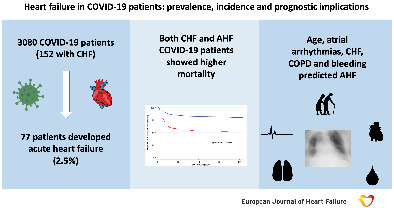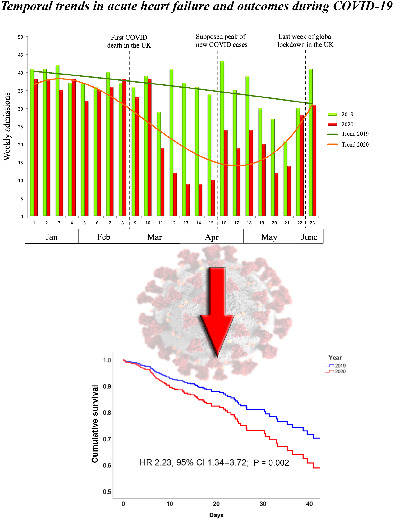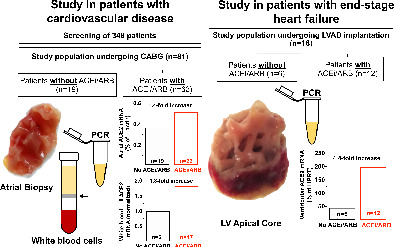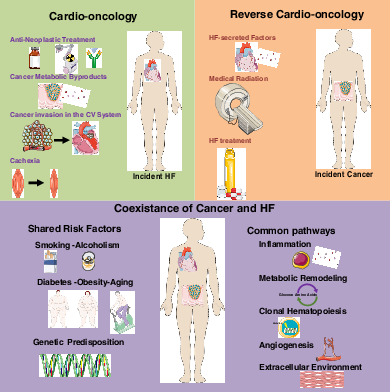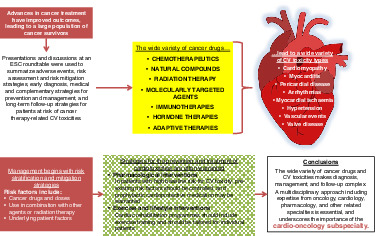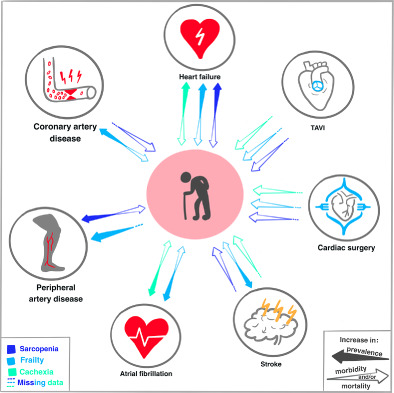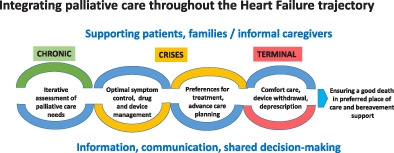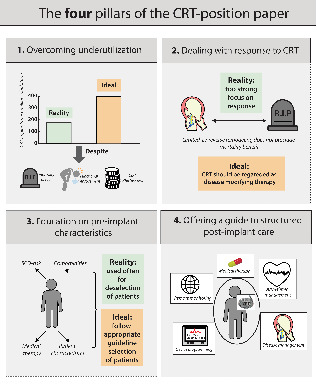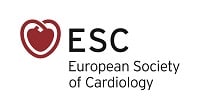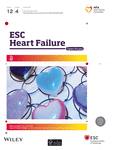Journal list menu
Export Citations
Download PDFs
ISSUE INFORMATION
INTRODUCTION
December 2020 at a glance: focus on COVID-19, comorbidities and palliative care
- Pages: 2173-2174
- First Published: 08 February 2021
POSITION PAPER
Standardized definitions for evaluation of heart failure therapies: scientific expert panel from the Heart Failure Collaboratory and Academic Research Consortium
- Pages: 2175-2186
- First Published: 05 October 2020
COVID-19
Viewpoint
COVID-19, myocarditis, and the other side of the bed
- Pages: 2187-2189
- First Published: 22 November 2020
Research article
In-hospital care in acute heart failure during the COVID-19 pandemic: insights from the German-wide Helios hospital network
- Pages: 2190-2201
- First Published: 02 November 2020
Editorial Comment
Discovery and care innovation amidst a pandemic
- Pages: 2202-2204
- First Published: 28 November 2020
Research article
Heart failure in COVID-19 patients: prevalence, incidence and prognostic implications
- Pages: 2205-2215
- First Published: 24 August 2020
Editorial comment
COVID-19: getting to the heart of the matter
- Pages: 2216-2218
- First Published: 18 September 2020
Research article
Temporal trends in decompensated heart failure and outcomes during COVID-19: a multisite report from heart failure referral centres in London
- Pages: 2219-2224
- First Published: 18 August 2020
Editorial comment
Hospitalizations for heart failure and mortality risk during the evolving coronavirus disease 2019 pandemic – the wave may break but a dangerous undertow persists
- Pages: 2225-2227
- First Published: 30 October 2020
Research articles
Haemodynamic characteristics of COVID-19 patients with acute respiratory distress syndrome requiring mechanical ventilation. An invasive assessment using right heart catheterization
- Pages: 2228-2237
- First Published: 16 November 2020
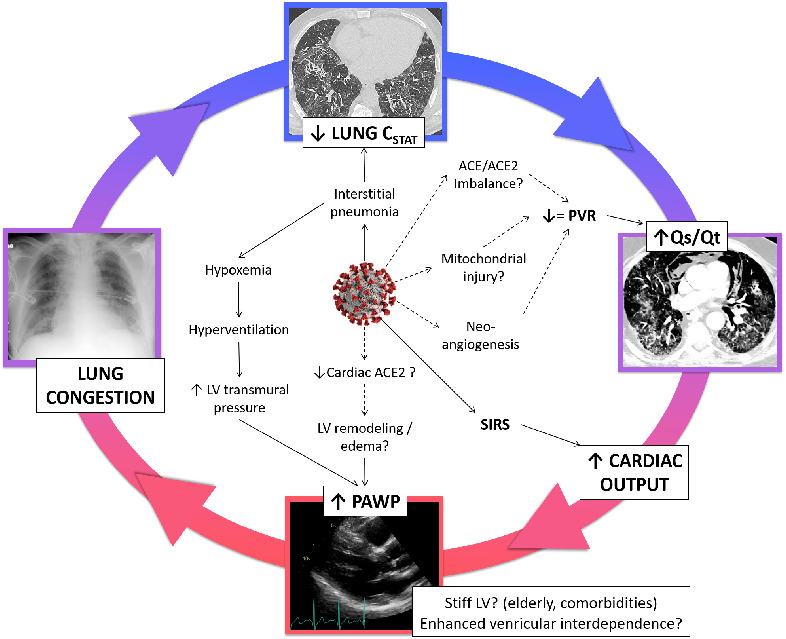
Vicious circle between the lung and the heart in COVID-19. Coronavirus-2 causes an interstitial pneumonia characterized by low lung compliance. The ventilation/perfusion mismatch of non-ventilated but perfused lung zones is enhanced by specific virus-related mechanisms, with blunted hypoxic pulmonary vasoconstriction and normal PVR, further promoting the intrapulmonary shunt. High cardiac output due to acute inflammation and hypoxaemia, with low PVR and unimpeded left ventricular preload, predisposes to high filling pressure, which might be favoured by patient characteristics (elderly with cardiovascular comorbidities) and further exacerbated by virus-related cardiac remodelling. High left ventricular filling pressure promotes lung congestion with further reduction of lung compliance. ACE, angiotensin-converting enzyme; CSTAT, static lung compliance; LV, left ventricle; PAWP, pulmonary artery wedge pressure; PVR, pulmonary vascular resistance; Qs/Qt, intrapulmonary shunt; SIRS, systemic inflammatory response syndrome.
Impact of heart failure on the clinical course and outcomes of patients hospitalized for COVID-19. Results of the Cardio-COVID-Italy multicentre study
- Pages: 2238-2247
- First Published: 12 November 2020
Angiotensin-converting enzyme inhibitor/angiotensin II receptor blocker treatment and haemodynamic factors are associated with increased cardiac mRNA expression of angiotensin-converting enzyme 2 in patients with cardiovascular disease
- Pages: 2248-2257
- First Published: 05 October 2020
REMODELLING
Research article
Prognostic impacts of dynamic cardiac structural changes in heart failure patients with preserved left ventricular ejection fraction
- Pages: 2258-2268
- First Published: 27 June 2020
Editorial comment
Ventricular remodelling: an equal-opportunity prognosticator
- Pages: 2269-2271
- First Published: 24 August 2020
CARDIO-ONCOLOGY
Position paper
Common mechanistic pathways in cancer and heart failure. A scientific roadmap on behalf of the Translational Research Committee of the Heart Failure Association (HFA) of the European Society of Cardiology (ESC)
- Pages: 2272-2289
- First Published: 22 October 2020
Review
Editorial comment
Is cardio-oncology a rapidly growing field of precision medicine?
- Pages: 2310-2313
- First Published: 11 November 2020
CACHEXIA AND FRAILTY
Review
Cachexia, muscle wasting, and frailty in cardiovascular disease
- Pages: 2314-2326
- First Published: 19 September 2020
PALLIATIVE CARE
Position paper
Integration of a palliative approach into heart failure care: a European Society of Cardiology Heart Failure Association position paper
- Pages: 2327-2339
- First Published: 06 September 2020
Research article
The impact of palliative care on clinical and patient-centred outcomes in patients with advanced heart failure: a systematic review of randomized controlled trials
- Pages: 2340-2346
- First Published: 16 March 2020
Editorial comment
What is what? From a palliative care approach to specialized palliative care in heart failure management
- Pages: 2347-2348
- First Published: 16 April 2020
CRT AND CONDUCTION DELAYS
Position paper
Optimized implementation of cardiac resynchronization therapy: a call for action for referral and optimization of care: A joint position statement from the Heart Failure Association (HFA), European Heart Rhythm Association (EHRA), and European Association of Cardiovascular Imaging (EACVI) of the European Society of Cardiology
- Pages: 2349-2369
- First Published: 02 November 2020
Research article
Prevalence and incidence of intra-ventricular conduction delays and outcomes in patients with heart failure and reduced ejection fraction: insights from PARADIGM-HF and ATMOSPHERE
- Pages: 2370-2379
- First Published: 28 July 2020
Editorial comment
The importance of electrocardiographic follow-up in heart failure
- Pages: 2380-2382
- First Published: 12 November 2020
CLINICAL TRIAL
Baseline characteristics of patients with heart failure with preserved ejection fraction in the EMPEROR-Preserved trial
- Pages: 2383-2392
- First Published: 29 November 2020
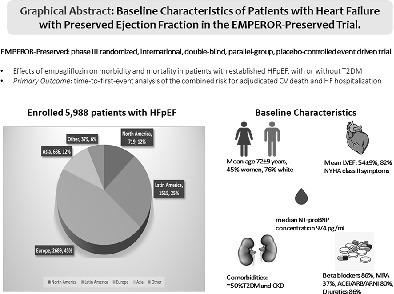
Baseline characteristics of patients with heart failure with preserved ejection (HFpEF) in the EMPEROR-Preserved trial. ACEi, angiotensin-converting enzyme inhibitor; ARB, angiotensin receptor blocker; ARNI, angiotensin receptor–neprilysin inhibitor; CKD, chronic kidney disease; CV, cardiovascular; LVEF, left ventricular ejection fraction; MRA, mineralocorticoid receptor antagonist; NT-proBNP, N-terminal pro B-type natriuretic peptide; NYHA, New York Heart Association; T2DM, type 2 diabetes mellitus.
STUDY DESIGN
Design of a prospective patient-level pooled analysis of two parallel trials of empagliflozin in patients with established heart failure
- Pages: 2393-2398
- First Published: 30 November 2020
CORRIGENDUM
Addendum to the article: ‘Improving risk prediction in heart failure using machine learning’ [Eur J Heart Fail 2020;22:139–147]
- Page: 2399
- First Published: 08 February 2021





